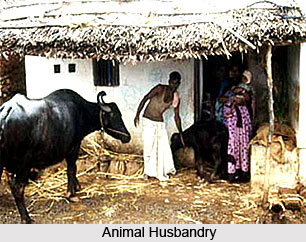 Livestock in India are raised for profit as well as for several other reasons. The country almost leads several other countries across the world in the number of cattle that account for a huge ratio. Livestock in India plays a vital role in the economic development of the country especially in rural areas where most of the livelihood depends on these sectors. Apart from food production, livestock has an important role to play in other areas too. It forms an excellent source fuel production for domestic use and manure for crop production. To a great extent it also reduces the use of non renewable energy.
Livestock in India are raised for profit as well as for several other reasons. The country almost leads several other countries across the world in the number of cattle that account for a huge ratio. Livestock in India plays a vital role in the economic development of the country especially in rural areas where most of the livelihood depends on these sectors. Apart from food production, livestock has an important role to play in other areas too. It forms an excellent source fuel production for domestic use and manure for crop production. To a great extent it also reduces the use of non renewable energy.
Condition of Livestock in India
In India, commercial grazing is conspicuously absent because of subsistence agriculture. In the villages, few animals are kept by every family. These animals are fed on straw and other by-products of agriculture. Moreover, in some uncultivated zones of the Indian plateau, grasses grow especially during the rainy season. These grasses are cut and stocked for feeding cattle during the dry months. Livestock in India are however not so flourishing. Pasturage is generally very poor. Stall feeding is restricted to irrigated areas and towns. Hence, quite a large number of animals are frail, unproductive and weak. Although a huge number of the animals are low grade and economically useless, yet they have an unrivalled place in the rural economy. In Indian villages, every farmer has at least a pair of bullocks except in the sandy tracts in the north western India. However steps have been taken in this regard to develop the livestock in India and promoting this sector as a significant and alternative source of income.

Uses of Livestock in India
Livestock in India have great usages. Power driven machines being very few for the agricultural operations, bullocks and other animals are used as draught animals. They are used for drawing ploughs and carts and lifting water from wells for irrigation purposes. Their dung makes excellent manure. Dried dung is commonly used as household fuel. Moreover, in semi-arid and arid tracts of north-western India and the interior Indian plateau, sheep are reared for wool as well as for mutton and goats for mutton and milk. Moreover, numerous goats and sheep are dispatched to big cities that are the major markets of mutton.
Draught animals are pre-requisite for every farmer in India. They are specifically fed more carefully. Buffaloes are mainly kept for milk whereas other cattle are exclusively used as draught animals. India also exports a small number of bulls to some tropical countries. A noteworthy number of cattle are found throughout the country but buffaloes being large sized animals are found in less numbers in mountainous terrains like Nagaland, Jammu and Kashmir and Himachal Pradesh. Cows are found in significant numbers in India. Buffaloes and cows are the animals that supply milk in this country. Milk sells at quite a higher rate in the country as compared to the American and European countries. Modern dairy industry is only restricted to big cities where there are factories producing milk products besides the milk plants.















